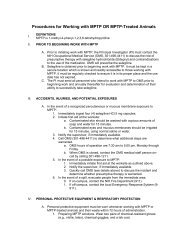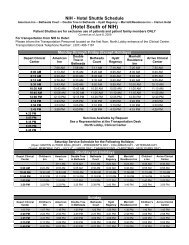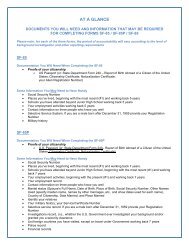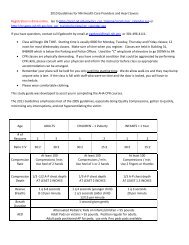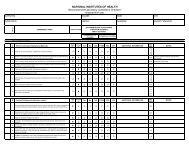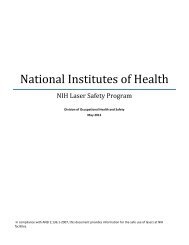NIH Laser Safety Program - ORS - National Institutes of Health
NIH Laser Safety Program - ORS - National Institutes of Health
NIH Laser Safety Program - ORS - National Institutes of Health
Create successful ePaper yourself
Turn your PDF publications into a flip-book with our unique Google optimized e-Paper software.
<strong>National</strong> <strong>Institutes</strong> <strong>of</strong> <strong>Health</strong> <br />
<strong>NIH</strong> <strong>Laser</strong> <strong>Safety</strong> <strong>Program</strong> <br />
Division <strong>of</strong> Occupational <strong>Health</strong> and <strong>Safety</strong><br />
May 2013<br />
In compliance with ANSI Z.136.1‐2007, this document provides information for the safe use <strong>of</strong> lasers at <strong>NIH</strong><br />
facilities.
Table <strong>of</strong> Contents<br />
Purpose ………………………………………………………………………………………………………..2<br />
Scope …………………………………………………………………………………………………………..2<br />
Responsibilities ………………………………………………………………………………………………..2<br />
References……... ……………………………………………………………………………………………..3<br />
Definitions…. ……………………………………………………………………………………….………....3<br />
<strong>Laser</strong> <strong>Safety</strong> <strong>Program</strong>…….…………………………………………………………………………………..5<br />
Appendices……………………………………..………………………………………………………………9<br />
1
1.0 PURPOSE<br />
The <strong>Laser</strong> <strong>Safety</strong> <strong>Program</strong> has been developed to provide guidance and oversight for the safe use<br />
<strong>of</strong> lasers and laser systems at the <strong>National</strong> <strong>Institutes</strong> <strong>of</strong> <strong>Health</strong> (<strong>NIH</strong>).<br />
2.0 SCOPE<br />
The <strong>Laser</strong> <strong>Safety</strong> <strong>Program</strong> applies to all <strong>NIH</strong> employees, contractors and students working at<br />
<strong>of</strong>ficial <strong>NIH</strong> facilities.<br />
3.0 RESPONSIBILITY<br />
3.1 <strong>Laser</strong> <strong>Safety</strong> Advisory Committee (LSAC)<br />
a) <strong>Laser</strong> safety program development and management; <br />
b) Verification <strong>of</strong> safety practices within laser laboratories using laser(s) or laser <br />
system(s);<br />
c) Investigate all incidents and accidents involving the use <strong>of</strong> lasers in <strong>NIH</strong> facilities; and<br />
d) Maintain an accurate inventory <strong>of</strong> class 3B and 4 laser(s) and laser system(s).<br />
3.2 <strong>Laser</strong> <strong>Safety</strong> Officer (LSO)<br />
a) Provide classification information concerning laser(s) and laser system(s); <br />
b) Provide laser safety training; <br />
c) Determine necessary safety information (evaluation and control measures) critical for <br />
the implementation <strong>of</strong> a laser laboratory as specified by ANSI Z136.-2007 American<br />
<strong>National</strong> Standard for Safe Use <strong>of</strong> <strong>Laser</strong>s and compliance to applicable laws;<br />
d) Provide information concerning the purchase <strong>of</strong> necessary laser safety materials (signs,<br />
labels, safety eyewear, etc); and<br />
e) Monitor and enforce program requirements. <br />
f) Conduct periodic review <strong>of</strong> the laser safety program <br />
3.3 Supervisors/ Principal Investigators (PI):<br />
a) Submit a Registration Form to the LSAC for all Class 3b and Class 4 laser(s) or laser<br />
system(s) (Appendix A);<br />
b) Identify all laser hazards and implement all appropriate hazard controls. If found,<br />
correct any identified unsafe or non-compliant conditions in the laboratory;<br />
c) Identify all personnel who may operate or maintain a Class 3b or Class 4 laser(s) or<br />
laser system(s). Ensure proper training for these authorized personnel;<br />
d) Monitor all authorized personnel for compliance with the <strong>Laser</strong> <strong>Safety</strong> <strong>Program</strong>;<br />
e) Ensure that laser(s) and laser system(s) are maintained adequately to ensure proper<br />
working order;<br />
f) Maintain a copy <strong>of</strong> this written program in the workplace.<br />
3.4 <strong>Laser</strong> User:<br />
a) Know all laboratory hazards and laboratory procedures for the safe use <strong>of</strong> laser(s) and<br />
laser system(s) in the work area;<br />
b) Attend required training(s) as specified by a supervisor, LSO, or LSAC;<br />
2
4.0 REFERENCES<br />
c) Complete all aspects <strong>of</strong> laser usage in accordance with the laser safety program and<br />
good safety practices;<br />
d) Use all personal protective equipment as specified in prescribed training or required<br />
by a supervisor, LSO, or LSAC;<br />
e) Immediately notify a supervisor, LSO, or LSAC <strong>of</strong> any hazards encountered.<br />
ANSI Z136.1-2007, American <strong>National</strong> Standard for Safe Use <strong>of</strong> <strong>Laser</strong>s<br />
ANSI Z136.3-2011, Safe Use <strong>of</strong> <strong>Laser</strong>s in <strong>Health</strong> Care Facilities<br />
29 CFR 1910.132, Personal protective equipment<br />
29 CFR 1910.133 (a), Eye and face protection<br />
STD 01-05-001, (OSHA) Guidelines for <strong>Laser</strong> <strong>Safety</strong> and Hazard Assessment<br />
21 CFR 1040.10, <strong>Laser</strong> Products<br />
21 CFR 1040.11, Specific purpose laser product<br />
HHS Publication FDA 86-8260, Compliance Guide for <strong>Laser</strong> Products<br />
5.0 DEFINITIONS<br />
Accessible emission limit (AEL): The maximum accessible emission level permitted within a <br />
particular laser hazard class. <br />
Authorized personnel: Any individual approved to work with a laser or laser system. <br />
Aversion response: An involuntary movement <strong>of</strong> either the head and /or eye to avoid exposure <br />
to a visible laser beam. <br />
Blink reflex: The involuntary closing and opening <strong>of</strong> the eye(s) as a result <strong>of</strong> external <br />
stimulation. <br />
Collecting optics: Lenses or optical instruments that use magnification to increase the power <strong>of</strong> <br />
a laser beam. <br />
Continuous wave (CW): A laser beam with an output greater than 0.25 seconds. <br />
Diffuse reflection: The reflecting <strong>of</strong> a laser beam in many directions by a surface.<br />
Divergence: The splitting <strong>of</strong> a laser beam so that the beam diameter increases with distance<br />
traveled.<br />
3
Embedded laser: A laser <strong>of</strong> a specific class that is reduced to a lower class due to the<br />
mechanisms and devices (engineering controls) that remove potential for contact.<br />
Fail-safe interlock: An engineering control where the failure <strong>of</strong> a single mechanical or<br />
electrical component <strong>of</strong> the interlock will cause the system to go into, or remain in, a safe mode.<br />
Infrared: In this standard, the region <strong>of</strong> the electromagnetic spectrum between the longwavelength<br />
extreme <strong>of</strong> the visible spectrum (about 0.7 m) and the shortest microwaves (about 1<br />
mm).<br />
Intrabeam viewing: The viewing condition whereby the eye is exposed to all or part <strong>of</strong> a laser<br />
beam.<br />
LSAC: <strong>Laser</strong> <strong>Safety</strong> Advisory Committee<br />
LSO: <strong>Laser</strong> <strong>Safety</strong> Officer<br />
LSP: The <strong>NIH</strong> <strong>Laser</strong> <strong>Safety</strong> <strong>Program</strong><br />
Maximum permissible exposure (MPE): The level <strong>of</strong> laser radiation to which an unprotected<br />
person may be exposed without adverse biological changes in the eye or skin.<br />
Nominal hazard zone (NHZ): The space within which the level <strong>of</strong> the direct, reflected, or<br />
scattered radiation may exceed the applicable MPE. Exposure levels beyond the boundary <strong>of</strong> the<br />
NHZ are below the appropriate MPE.<br />
Non-beam hazard: A class <strong>of</strong> hazards that result from factors other than direct human exposure<br />
to a laser beam.<br />
Protective housing: An enclosure that surrounds the laser or laser system and prevents access<br />
to laser radiation above the applicable MPE. The aperture through which the useful beam is<br />
emitted is not part <strong>of</strong> the protective housing. The protective housing limits access to other<br />
associated radiant energy emissions and to electrical hazards associated with components and<br />
terminals, and may enclose associated optics and a workstation.<br />
Pulsed laser: A laser which delivers its energy in the form <strong>of</strong> a single pulse or a train <strong>of</strong> pulses.<br />
In this standard, the duration <strong>of</strong> a pulse is less than 0.25 s.<br />
Q-Switch: is a technique by which a laser can be made to produce a pulsed output beam. The<br />
technique allows the production <strong>of</strong> light pulses with extremely high (gigawatt) peak power,<br />
much higher than would be produced by the same laser if it were operating in a continuous wave<br />
(constant output) mode.<br />
Q-switched laser: A laser that emits short (~10-250 ns), high-power pulses by means <strong>of</strong> a Q-<br />
switch.<br />
4
<strong>Safety</strong> latch: A device intended to provide a measure <strong>of</strong> safety that must physically be removed<br />
to allow exposure to a hazard.<br />
Specular reflection: A mirror-like reflection.<br />
Thermal effect: Temperature elevation caused by exposure to a laser beam.<br />
Threshold limit (TL): The term is applied to laser protective eyewear filters, protective<br />
windows, and barriers. The TL penetration <strong>of</strong> a laser protective device. This is generally related<br />
by the Threshold Limit (TL) <strong>of</strong> the protective device, expressed in W cm -2 or J cm -2 . It is the<br />
maximum average irradiance or radiant exposure at a given beam diameter for which a laser<br />
protective device provides adequate beam resistance. Thus, laser exposures delivered on the<br />
protective device at or below the TL will limit beam penetration to levels at or below the<br />
applicable MPE.<br />
Ultraviolet radiation: In this standard, electromagnetic radiation with wavelengths between<br />
0.18 and 0.40 m (shorter than those <strong>of</strong> visible radiation).<br />
Wavelength: The distance in the line <strong>of</strong> advance <strong>of</strong> a sinusoidal wave from any one point to the<br />
next point <strong>of</strong> corresponding phase (e.g., the distance from one peak to the next).<br />
6.0 PROGRAM<br />
6.1 <strong>Laser</strong> <strong>Safety</strong> <strong>Program</strong><br />
The <strong>Laser</strong> <strong>Safety</strong> <strong>Program</strong> (LSP) was established to promote health and safety in the use <strong>of</strong> lasers<br />
and laser systems, focusing on Class 3b and 4, for laser users at the <strong>NIH</strong>. The LSP is administered<br />
by the Division <strong>of</strong> Occupational <strong>Health</strong> and <strong>Safety</strong> (DOHS) through the laser safety <strong>of</strong>ficer<br />
(LSO).<br />
The <strong>NIH</strong> LSP is based on recommendations from ANSI Z136.1-2007, as well as, the other laser<br />
guidelines listed in the references section (Section 4). The LSP and guidance documents are<br />
used to ensure compliance with the required sections <strong>of</strong> the Code <strong>of</strong> Federal Regulations also<br />
listed in Section 4. The control measures outlined herein shall not be considered to restrict or<br />
limit in any way the use <strong>of</strong> laser radiation <strong>of</strong> any type which may be intentionally administered<br />
to an individual for diagnostic, therapeutic, or medical research purposes by or under the<br />
direction <strong>of</strong> qualified pr<strong>of</strong>essionals engaged in health care. However, those administering and<br />
assisting in the administering <strong>of</strong> the laser radiation, as well as the patient, where applicable, shall<br />
be protected by the control measures as outlined herein and, as applicable, by the requirements<br />
as specified in the American <strong>National</strong> Standard for <strong>Laser</strong> <strong>Safety</strong> in <strong>Health</strong> Care Facilities, ANSI<br />
Z 136.3.<br />
The LSP at <strong>NIH</strong> is an established program with a mandate to ensure the proper training for all<br />
users, maintain an accurate inventory <strong>of</strong> class 3b and 4 laser(s) and laser system(s), document<br />
annual surveys <strong>of</strong> class 3b and 4 laser(s) and laser system(s) locations, and ensure the proper<br />
response to accidents and incidents involving laser(s) and laser systems(s).<br />
5
6.2 <strong>Laser</strong> Classification<br />
A. Class 1<br />
1. Understood to be a non-hazardous source during usage intended by manufacturer.<br />
2. Not intended to be monitored by this LSP<br />
a. No surveillance or audits.<br />
b. No control measures for usage.<br />
B. Class 1M<br />
1. A class 1 system that may become hazardous if viewed with an optical<br />
instrument.<br />
2. Not intended to be monitored by this LSP<br />
a. No surveillance or audits<br />
b. Control measures: ensure no optically aided viewing.<br />
C. Class 2<br />
1. A laser with power less than or equal to 1 milliwatt.<br />
2. A laser within the visual spectrum (400 nanometers – 700 nanometers).<br />
3. Not intended to be monitored by this LSP<br />
a. No surveillance or audits<br />
b. Control measures – Understood that the natural aversion response is<br />
sufficient to protect the eyes from damage.<br />
D. Class 2M<br />
1. A class 2 system that may become hazardous if viewed with an optical<br />
instrument.<br />
2. Not intended to be monitored by this LSP<br />
a. No surveillance or audits<br />
b. Control measures – ensure no optically aided viewing.<br />
E. Class 3R<br />
1. A laser with power less than 5 milliwatt.<br />
2. May be dangerous from both direct viewing and specular reflections if natural<br />
aversion responses are not functioning properly.<br />
3. Not intended to be monitored by this LSP<br />
a. No surveillance or audits<br />
b. Control measures – ensure no optically aided viewing.<br />
F. Class 3B<br />
1. A laser with power less than or equal to 0.5 watts.<br />
2. May be dangerous from both direct viewing and specular reflections.<br />
3. Not a fire hazard.<br />
4. Intended to be monitored by this LSP<br />
a. Minimum <strong>of</strong> an annual survey for compliance to the LSP<br />
6
. Control measures – See section 6.4: <strong>Laser</strong> Hazard Control<br />
Measures for more detailed information regarding specific control<br />
measures.<br />
G. Class 4<br />
1. A laser with power that exceeds a Class 3b.<br />
2. Hazardous to both eyes and skin when beam makes direct contact or from specular<br />
reflection.<br />
3. May be a fire hazard<br />
4. Intended to be monitored by this LSP<br />
a. Minimum <strong>of</strong> an annual survey for compliance to the LSP<br />
b. Control measures – See section 6.4: <strong>Laser</strong> Hazard Control<br />
Measures for more detailed information regarding specific control<br />
measures.<br />
6.3 <strong>Laser</strong> Acquisition and Transfer<br />
It is the sole responsibility <strong>of</strong> the Principal Investigator to document and report to the LSAC the<br />
purchase <strong>of</strong> a class 3b or 4 laser or laser system. The PI may choose to delegate this function,<br />
however, the ultimate responsibility for success or failure <strong>of</strong> the reporting remains the same.<br />
Appendix A is the standard form that is to be used for submission. Please forward the completed<br />
form to the <strong>Laser</strong> <strong>Safety</strong> Advisory Committee, <strong>NIH</strong>, Building 13, Room 3K04.<br />
6.4 <strong>Laser</strong> Hazard Control Measures<br />
A. Controls for Class 3b and Class 4 <strong>Laser</strong>s<br />
1. Posting – At minimum, the entryway <strong>of</strong> a laser safety area must be posted for<br />
the class <strong>of</strong> laser, laser power, and laser wavelength(s). Additionally, it may be<br />
necessary to post inside the laser safety area to further define the hazard.<br />
2. Authorization – Only individuals who have been trained by a designated<br />
<strong>of</strong>ficial may enter and utilize a laser <strong>of</strong> class 3b or 4. No other individuals shall<br />
have the means to utilize the laser or laser system.<br />
3. Beam trajectory and control – The laser may only be utilized after the beam<br />
manner is well characterized and understood. The beam should be controlled to<br />
not be at either standing or sitting heights. Additionally, an appropriate beam<br />
stop must be utilized to terminate the beam.<br />
4. Non-beam hazards – All non-laser materials that have the potential to come<br />
into contact with the laser beam must be analyzed to determine if any hazards<br />
are created upon contact over a period <strong>of</strong> time. When no written information is<br />
available to describe conditions created by contact, the responsible party should<br />
assume a hazardous product and ensure a proper means to eliminate the hazard.<br />
The most common means <strong>of</strong> controlling non-beam hazards is the use <strong>of</strong> local<br />
exhaust ventilation, essentially a mechanical means <strong>of</strong> purging an atmosphere<br />
through the use <strong>of</strong> controlled, directional air flow. Additional non-beam<br />
hazards are described in section 6.5.<br />
5. Personal Protective Equipment (PPE) – All class 3b and 4 laser usage areas<br />
must have a written document providing the required PPE to be used while<br />
7
working with the laser. The most common PPE for use with lasers is protective<br />
eye wear. It is critical that eye wear be appropriate to the laser used. All PPE<br />
must be inspected before use for conditions that would negate the effectiveness<br />
<strong>of</strong> the protective device.<br />
6. Containment – All class 3b and 4 laser(s) and laser system(s) should utilize a<br />
means <strong>of</strong> containment that fully encloses the beam path and any potential<br />
reflections <strong>of</strong> the beam <strong>of</strong>f <strong>of</strong> surfaces. Building materials utilized in a laser<br />
area(s) should be analyzed for reflective potential, and when possible altered to<br />
decrease reflectance to as low a level as achievable. Windows to spaces outside<br />
<strong>of</strong> the laser area should be removed or covered to block transmission <strong>of</strong> the<br />
laser. Engineering controls like laser activation entry lights and key switches<br />
should be used at all times to ensure effective containment and control.<br />
7. Rapid Egress and Emergency Access – All class 4 laser area(s) must have a<br />
controlled means <strong>of</strong> rapid egress and admittance for emergency conditions.<br />
6.5 <strong>Laser</strong> Related Non-Beam Hazards & Control Measures<br />
A. Electrical Hazards – Many incidents and accidents related to laser(s) and laser system(s)<br />
stems not from the laser beam, but from user interaction with electrical components<br />
required for the laser to function. Most class 3b and 4 lasers utilize high voltages and<br />
large capacitors which have a high potential for electrical accidents. Only highly trained<br />
users should be authorized by the PIs to complete work involving electrical components.<br />
Any work involving electrical components must comply with the <strong>NIH</strong> Lockout/Tagout<br />
procedures and guidelines.<br />
B. <strong>Laser</strong> Dyes – Dyes used as lasing mediums are <strong>of</strong>ten classified as toxic, carcinogenic<br />
and/or flammable. These chemicals must be handled appropriately and material safety<br />
data sheets for each must be on file within the laser use area.<br />
C. <strong>Laser</strong> Generated Air Contaminants (LGAC) – Contact between a laser beam and a material<br />
can cause specific; yet, sometimes unknown contaminants to be released into the<br />
atmosphere <strong>of</strong> the laser use area. Periodically this release <strong>of</strong> air contaminate may occur<br />
without noticeable signs, such as smoking <strong>of</strong> the material contacted. Proper room<br />
ventilation or local exhaust ventilation is critical in any laser use area, and must be<br />
evaluated before the installation <strong>of</strong> a class 3b or 4 laser. The use <strong>of</strong> respiratory protection<br />
is not an accepted means <strong>of</strong> controlling the generated airborne hazard.<br />
D. UV and Visible-Radiation and plasma emissions – Evaluations for the discharge <strong>of</strong><br />
radiation, both visible and UV; and, plasma formation must be completed before the use<br />
<strong>of</strong> a class 3b or 4 laser. Identification <strong>of</strong> any <strong>of</strong> these conditions requires a review <strong>of</strong> the<br />
PPE used for skin protection to ensure adequate safety coverage. Additionally, laser and<br />
laser system components must be periodically surveyed for damage from these<br />
conditions.<br />
8
6.6 <strong>Laser</strong> <strong>Safety</strong> Training<br />
All supervisors and users must successfully complete the <strong>NIH</strong> <strong>Laser</strong> <strong>Safety</strong> training before using<br />
a class 3b or 4 laser or laser system. Completion <strong>of</strong> an alternate training class must be submitted<br />
to the LSAC for approval before laser usage may occur. Retraining is required every two years<br />
after initial training, or as required by either the PI or LSAC or if an accident occurs.<br />
6.7 <strong>Laser</strong> <strong>Safety</strong> Survey<br />
A laser safety survey is completed annually for all class 3b and 4 laser and laser systems. <strong>Safety</strong><br />
surveys can be completed by the LSO, an appropriately trained Occupational <strong>Safety</strong> and <strong>Health</strong><br />
Specialist, or a safety survey team involving personnel from the LSAC and the laser use area. The<br />
laser safety survey form is attached as appendix B. Deficiencies found will require a response by<br />
the PI or designee concerning modifications to made to resolve the issue. No usage <strong>of</strong> the laser(s)<br />
or laser system(s) should occur before the modifications are made unless the LSAC grants a<br />
written waiver to the PI.<br />
6.8. Medical Surveillance and <strong>Laser</strong> Accidents<br />
Individuals who believe that they require a medical evaluation concerning their use <strong>of</strong> laser(s) or<br />
laser system(s) must make a request through their respective supervisor. All requests will be<br />
conducted by Occupational Medical Services (OMS). Standard annual medical evaluations will<br />
not be conducted for <strong>NIH</strong> laser users.<br />
In the event <strong>of</strong> any accidents or incidents involving a class 3b or 4 laser or laser system the user<br />
must immediately notify their supervisor. The user must undergo and immediate evaluation by<br />
OMS located on the sixth floor <strong>of</strong> building 10, Room 6C306. The phone number for OMS is<br />
(301) 496-4411.<br />
7.0 APPENDIX<br />
Appendix A, <strong>Laser</strong> <strong>Safety</strong> Inventory Form<br />
Appendix B, <strong>Laser</strong> <strong>Safety</strong> Survey Form<br />
Appendix C, <strong>Laser</strong> <strong>Safety</strong> General SOP<br />
9
<strong>National</strong> <strong>Institutes</strong> <strong>of</strong> <strong>Health</strong> (<strong>NIH</strong>) <strong>Laser</strong> <strong>Safety</strong> <strong>Program</strong><br />
Appendix A: Inventory Form<br />
Principal Investigator Laboratory Room Number Date<br />
<strong>Laser</strong> Information:<br />
1. Locations:<br />
2. Manufacturer:<br />
3. Model:<br />
4. Serial Number:<br />
5. <strong>NIH</strong> Asset Tag Number:<br />
Hazard Class: 3b 4<br />
Technical Specifications:<br />
Type<br />
Wavelength(s)<br />
Output Power(s) Φ0:<br />
(Lasing<br />
Media)<br />
(nm):<br />
Pulsed:<br />
Energy:<br />
Length:<br />
Rate:<br />
Yes<br />
No<br />
(J)<br />
(s)<br />
(Hz)<br />
Research Name<br />
Date <strong>of</strong> Training (most recent)<br />
DOHS/<strong>ORS</strong> Updated 4/2012
<strong>NIH</strong> Inventory Number (s)<br />
<strong>National</strong> <strong>Institutes</strong> <strong>of</strong> <strong>Health</strong> (<strong>NIH</strong>) <strong>Laser</strong> <strong>Safety</strong> <strong>Program</strong><br />
Appendix B: Inspection Form<br />
<strong>Laser</strong> Information:<br />
1. Locations:<br />
2. Manufacturer:<br />
3. Model:<br />
4. Serial Number:<br />
5. <strong>NIH</strong> Asset Tag Number:<br />
Hazard Class: 3b 4<br />
Technical Specifications:<br />
OK<br />
Discrepancy:<br />
Type<br />
Wavelength(s)<br />
Output Power(s) Φ0:<br />
(Lasing<br />
Media)<br />
(nm):<br />
Pulsed:<br />
Energy:<br />
Length:<br />
Rate:<br />
Yes<br />
No<br />
(J)<br />
(s)<br />
(Hz)<br />
Beam Diameter (cm):<br />
Divergence (mrad):<br />
Output Irradiance E (W/cm 2 ):<br />
MPE:<br />
Minimum OD:<br />
Equipment Grounded: Yes No<br />
Warning Signs and Labels:<br />
Warning Label(s) visible:<br />
Location:<br />
Warning Sign(s) visible:<br />
Location:<br />
Warning System Type(s):<br />
Yes<br />
Yes<br />
audible<br />
light<br />
No<br />
No<br />
verbal<br />
Key Control (On/Off switch, class 4 only) Yes No<br />
Protective Housing:<br />
If no,<br />
Access Restriction & Area Control<br />
PPE Available (including eye)<br />
Barriers, curtains, beam stops, etc<br />
SOPs written and available<br />
Yes<br />
Yes<br />
Yes<br />
Yes<br />
Yes<br />
No<br />
No<br />
No<br />
No<br />
No<br />
Inspection Form, Page 2<br />
<strong>NIH</strong> Inventory Number (s)<br />
DOHS/<strong>ORS</strong> Updated 4/2012
Adminstrative Procedures & Documentation<br />
Manufacturer's Operation Manual Available<br />
SOP(s) Available<br />
General <strong>Safety</strong> Precautions and NHZ Description<br />
Personal Protective Equipment Requirements and Use<br />
Alignment Procedures<br />
Emergency Procedures<br />
Non-Beam Hazards<br />
Fire Extinguisher Available<br />
Type<br />
Last Inspection Date<br />
Emergency Egress Maintained<br />
Dyes / Solvents Used<br />
if yes, List<br />
MSDS Available<br />
Containment (Spill Protection)<br />
PPE Specified and Available<br />
Other Hazards (Mechanical, Compressed Gas, Ergonomic, Noise, etc.<br />
if yes, List<br />
Personal Protective Eyewear<br />
Manufacturer<br />
Model<br />
OD / Wavelength<br />
Lead Inspector Signature Date:<br />
DOHS/<strong>ORS</strong> Updated 4/2012
<strong>National</strong> <strong>Institutes</strong> <strong>of</strong> <strong>Health</strong> (<strong>NIH</strong>) <strong>Laser</strong> <strong>Safety</strong> <strong>Program</strong><br />
Appendix C: General <strong>Laser</strong> <strong>Safety</strong> SOP<br />
Instructions for completion <strong>of</strong> the generic SOP & related documents<br />
Section 1: Hazard Evaluation Document<br />
Classification <strong>of</strong> <strong>Laser</strong>s:<br />
<br />
<br />
<br />
Can be found within the operations manual<br />
Should be posted on the laser itself either with an identification tag or similar by the<br />
manufacturer<br />
If you cannot find specific information regarding your laser, please contact the<br />
manufacturer for information and specifications<br />
Beam Paths:<br />
<br />
<br />
<br />
Open Beam Path - There are several specific application areas where high power<br />
(Class IIIB and Class IV) lasers are used in an unenclosed beam condition. This<br />
would include, for example, open industrial processing systems (<strong>of</strong>ten incorporating<br />
robotic delivery), laser research laboratory installations, surgical installations, etc.<br />
Partially Enclosed Beam Path- It is becoming an accepted work practice,<br />
particularly with industrial materials-processing lasers, to build an enclosure that<br />
completely surrounds the laser-focusing optics and the immediate area <strong>of</strong> the<br />
workstation. Often a computer-controlled positioning table is located within this<br />
enclosure. The design <strong>of</strong>ten allows a gap <strong>of</strong> less than one quarter <strong>of</strong> an inch between<br />
the bottom <strong>of</strong> the enclosure and the top <strong>of</strong> the material to be laser processed. Such a<br />
design enables the part to be laser cut or welded to move while the laser delivery<br />
optics remains stationary.<br />
Enclosed Beam Path- Perhaps the most common form <strong>of</strong> a Class I laser system is a<br />
high-power laser that has been totally enclosed (embedded) inside a protective<br />
enclosure equipped with appropriate interlocks and/or labels on all removable panels<br />
or access doors. Beam access is prevented, therefore, during operation and<br />
maintenance.<br />
Non Beam Hazard Examples: <br />
<br />
Electrical hazards, reflective surfaces, prevention <strong>of</strong> unauthorized users
1. HAZARD EVALUATION DOCUMENT OUTLINE<br />
for Class IIIb & Class IV <strong>Laser</strong> Users<br />
GENERAL INFORMATION<br />
TITLE<br />
LOCATION<br />
Bldg.-Room DIVISION LASER SAFETY CONTACT<br />
DESCRIPTION OF ACTIVITY<br />
Provide description including unique equipment, its application or activity and principal parameters.<br />
DURATION (Check One Box)<br />
Ongoing<br />
Limited Period; Enter # <strong>of</strong> Months<br />
IDENTIFICATION OF HAZARDS<br />
<strong>Laser</strong><br />
Other (Please explain in space provided below)<br />
Toxic Gases<br />
Electrical<br />
Radioactive Materials<br />
Toxic Chemicals
MITIGATION OF HAZARDS<br />
Controls to reduce the potential hazards. From a laser perspective, the following need to be addressed: Identification <strong>of</strong><br />
laser(s): <strong>Laser</strong> specifications<br />
Complete the following chart (as much as possible), list all lasers, including low power alignment lasers:<br />
Type:<br />
<strong>Laser</strong> 1 <strong>Laser</strong> 2 <strong>Laser</strong> 3<br />
Manufacturer:<br />
Model:<br />
Serial #:<br />
Maximum<br />
Power or<br />
Energy<br />
Wavelength<br />
Range<br />
Wavelength<br />
Used<br />
Power or<br />
Energy Used<br />
Pulse Length<br />
Pulse<br />
Repetition Rate<br />
Beam Diameter<br />
Beam<br />
Divergence<br />
FDA Barcode<br />
Made In-House?<br />
Class
LASER USERS<br />
Employee<br />
Date<br />
<strong>Laser</strong> <strong>Safety</strong> Training<br />
Completed<br />
Date<br />
Eye Examination<br />
Completed (where applicable)<br />
ATTACH A DIAGRAM OF LASER USE AREA (A simple block diagram is sufficient. The diagram should also<br />
be posted on lab door.)<br />
DESCRIBE ACCESS CONTROLS, INCLUDING USE OF INTERLOCKS<br />
DESCRIBE ALIGNMENT PROCEDURES<br />
WHERE HAVE LASER WARNING SIGNS BEEN POSTED?<br />
(Warning signs can be obtained from the laser manufacturer or the LSO)
LASER PROTECTIVE EYEWEAR<br />
Number <strong>of</strong><br />
Pairs<br />
on Hand<br />
Location <strong>of</strong><br />
Eyewear<br />
Manufacturer Optical Density Wavelength<br />
BEAM PATH – Open, Enclosed, or Partially Enclosed<br />
NON-BEAM HAZARDS (Include non-laser items identified as hazards)<br />
HAZARD<br />
CONTROL MEASURE<br />
MAINTENANCE<br />
Equipment will be maintained in accordance with manufacturers recommended procedures. System safety<br />
devices will be tested and documented. Accurate records will be kept <strong>of</strong> tests, calibrations, adjustments,<br />
and repairs done. The door interlock will be checked quarterly and a record kept.<br />
EMERGENCY PROCEDURES<br />
Authorized laser users will be familiar with the Building Emergency Plan, location <strong>of</strong> emergency equipment,<br />
and emergency procedures for fires, and evacuations. Emergency shut-<strong>of</strong>f procedures for lasers consist <strong>of</strong><br />
shutting <strong>of</strong>f the electrical power to the laser system. The main electrical shut-<strong>of</strong>f switches to the laser should<br />
be labeled.<br />
ANNUAL REVIEW SCHEDULE<br />
If new hazards have been introduced, a full review will be required. If no changes other than users have been<br />
made (an update <strong>of</strong> the users list will be sent to LSO) the existing SOP will be considered valid. Concurrence<br />
<strong>of</strong> the LSO shall be obtained.
SAMPLE SOP TO BE POSTED FOR CLASS IIIb OR IV LASER USE<br />
WARNING<br />
<strong>Laser</strong>s can cause irreparable blindness if used improperly. Exposure <strong>of</strong> the eye to either the direct beam or a<br />
beam reflected from a flat mirror-like surface can cause an injury to the unprotected eye. Class IV lasers<br />
may also pose a potential hazard when viewing a diffuse reflection <strong>of</strong> the beam and may also pose a skin<br />
hazard. The following control measures will assist with preventing hazardous exposure during laser<br />
operations:<br />
Note: this SOP should be tailored for individual applications and requirements.<br />
1. Equipment should only be operated by personnel who have received proper training for the operation <strong>of</strong><br />
the laser. Refer to operators' manual for startup and operating procedures.<br />
2. Operating personnel shall periodically read and shall always follow this safety SOP.<br />
3. Remove all watches and reflective jewelry prior to operating the laser.<br />
4. Remove the key from the key switch when the laser is not in use.<br />
5. Never direct the laser at unprotected personnel.<br />
6. Wear laser protective eyewear whenever the laser is operated with an unenclosed beam.<br />
7. All personnel within the laser controlled area shall wear laser protective eyewear during laser<br />
operation. The laser operator shall assure that laser protective eyewear is being worn prior to<br />
commencing laser operation.<br />
8. Prior to laser operations, complete the following checklist:<br />
(a)<br />
(b)<br />
(c)<br />
Periodically test door electrical interlock switches.<br />
Select appropriate laser protective eyewear for the laser(s) to be operated. Ensure that laser<br />
protective eyewear is marked with its protective characteristics.<br />
Test warning lights or alarms to the laser controlled area.<br />
(d) Post a warning sign at the entrance(s) to the laser controlled area.<br />
(e)<br />
(f)<br />
Periodically check that all Warning and Certification labels are attached to the laser.<br />
Insure that any other required safety devices are available.<br />
9. A lens used to focus the laser beam <strong>of</strong> Class IIIb and Class IV lasers will increase the eye hazards from<br />
diffuse reflections and the skin hazards around the focal point.<br />
10. Immediately report any suspected injury, or defective equipment, to your supervisor, the <strong>NIH</strong> <strong>Laser</strong><br />
<strong>Safety</strong> Officer and where applicable OMS so that appropriate action may be taken.
LASER SYSTEM INFORMATION<br />
<strong>Laser</strong> Manufacturer:<br />
<strong>Laser</strong> Model:<br />
<strong>Laser</strong> Serial Number:<br />
<strong>NIH</strong> Decal / Barcode:<br />
<strong>Laser</strong> Type:<br />
<strong>Laser</strong> Class:<br />
Wavelength: nm Output (Max/used): W or J (circle one)<br />
Beam Diameter at Aperture: mm Beam Divergence: mrad<br />
Pulse Duration: sec Pulse Frequency: Hz <br />
<strong>Laser</strong> is Q-Switched/Mode Locked: Y or N (circle one) <br />
<strong>Laser</strong> is: active or inactive (circle one) <br />
LASER POSTING, LABELING AND SECURITY MEASURES<br />
Entrances properly posted: Y N Comments:<br />
Room security adequate: Y N Comments:<br />
Door interlock system: Y N NA Comments:<br />
<strong>Laser</strong> status indicator outside room: Y N NA Comments:<br />
<strong>Laser</strong> class label in place: Y N Comments:<br />
<strong>Laser</strong> hazard label in place: Y N Comments:<br />
<strong>Laser</strong> aperture label in place: Y N Comments:<br />
LASER UNIT SAFETY CONTROLS<br />
Protective housing in place: Y N Comments:<br />
Interlock on housing: Y N NA Comments:<br />
Interlock on housing is functioning: Y N Comments:<br />
Beam shutter present: Y N Comments:<br />
Beam shutter is functioning: Y N Comments:
Key operation: Y N Comments:<br />
<strong>Laser</strong> emission indicator on laser: Y N Comments:<br />
<strong>Laser</strong> emission indicator on console (or power supply): Y N Comments:<br />
Beam power meter: Y N Comments:<br />
Emergency shut<strong>of</strong>f available: Y N Comments:<br />
ENGINEERING SAFETY CONTROLS<br />
<strong>Laser</strong> secured to table: Y N Comments:<br />
<strong>Laser</strong> optics secured to prevent stray beams: Y N Comments:<br />
<strong>Laser</strong> at eye level: Y N Comments:<br />
<strong>Laser</strong> beam at eye level: Y N Comments:<br />
<strong>Laser</strong> beam is enclosed: Y N Comments:<br />
Beam barriers in place: Y N Comments:<br />
Beam stops in place: Y N Comments:<br />
Remote viewing <strong>of</strong> beam: Y N Comments:<br />
Beam condensed or enlarged: Y N Comments:<br />
Beam focused: Y N Comments:<br />
Beam intensity reduced through filtration: Y N Comments:<br />
Fiber optics used: Y N Comments:<br />
Windows in room covered: Y N Comments:<br />
Reflective materials kept out <strong>of</strong> beam path: Y N Comments:<br />
Beam management documented: Y N Comments:<br />
Physical evidence <strong>of</strong> stray beams: Y N Comments:<br />
Class IV diffuse reflection hazard: Y N Comments:
ADMINISTRATIVE SAFETY CONTROLS<br />
Authorization up-to-date: Y N Comments:<br />
Authorization posted: Y N Comments:<br />
SOP up-to-date: Y N Comments:<br />
SOP posted: Y N Comments:<br />
Emergency contact list posted: Y N Comments:<br />
<strong>Laser</strong> safety guidelines posted: Y N Comments:<br />
<strong>Laser</strong> safety policy manual available: Y N Comments:<br />
OTHER LASER SAFETY MEASURES<br />
Eye exam requirement met: Y N Comments:<br />
Proper laser protective eyewear available: Y N Comments:<br />
Proper skin protection available: Y N Comments:<br />
All users have met training requirement: Y N Comments:<br />
NON-BEAM HAZARDS<br />
Toxic laser media in use: Y N Comments:<br />
Fume hood for dye mixing: Y N Comments:<br />
Cryogens in use: Y N Comments:<br />
Compressed gasses in use: Y N Comments:<br />
Compressed gas cylinders secured: Y N Comments:<br />
High voltage power hazard: Y N Comments:<br />
Optical tables properly grounded: Y N Comments: <br />
Collateral radiation hazard: Y N Comments:<br />
Explosion hazard: Y N Comments:<br />
Fire hazard: Y N Comments:<br />
<strong>Laser</strong> Generated Airborne Contaminants production: Y N Comments:




